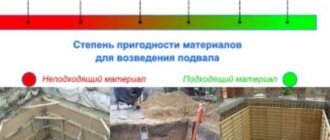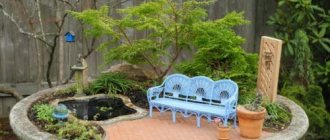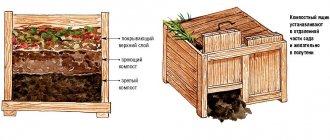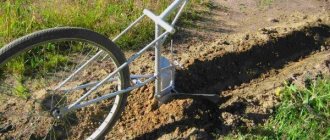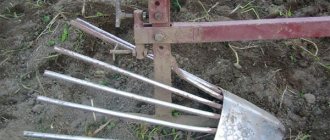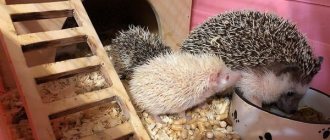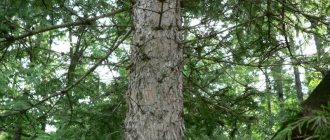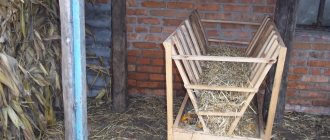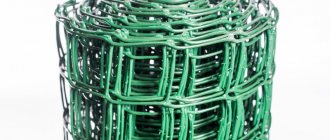What are hedgehogs for weeding potatoes and why are they needed?
Hedgehogs are an important agricultural tool, the main purpose of which is to save the gardener’s time and effort through high-quality and careful weeding of potato beds.
Along with their main function, they successfully loosen the soil and hill up emerging seedlings, while at the same time scaring off moles and other rodents in the cultivated soil.
What is their advantage
The advantage of hedgehogs for weeding potatoes, in addition to functionality, is that they can be used with all types of cultivators (manual, electric or gasoline).
This makes the tool suitable for use both in small individual areas and on an industrial scale.
The main advantages of hedgehogs
The so-called hedgehogs are a device that, as a rule, consists of several rings of different diameters. The circles are located at some distance from each other, and along their edges there are pins that rid the potato plantings of weeds. The design is usually paired, the components are attached to each other at a certain angle.
This equipment has enough advantages. The main ones are the following:
- Allows you to quickly get rid of weeds. Moreover, the potato bushes remain undamaged, and unnecessary grass is completely torn out by the roots.
- Along with weeding, this design loosens and fluffs up the soil well. After this treatment, the potatoes will grow well - there will be access to air and moisture absorption will improve.
- Potato plantings acquire an aesthetic appearance, and the structure of the row is preserved.
In general, the design is very useful and necessary. Plus, it’s worth noting that this device for weeding potatoes can be used on absolutely any soil, as well as any area. As a rule, hedgehogs are purchased together with a walk-behind tractor - they are included as a kit. But what if you still don’t have this design? There is no need to be upset - the necessary equipment can be ordered from the supplier.
What are they?
Despite the fact that the main function of all hedgehogs is the same, there are several types of such tools, with slightly different designs.
Differences affect the effectiveness of a hedgehog in an area of one size or another.
For processing potatoes in one furrow
Single-furrow potato hedgehogs are designed for weeding small areas. The simplified design of this type of hedgehog makes the work of the gardener easier, representing a pipe 250 mm long, on which several disks with metal spikes 150-200 mm long are fixed.
Fastening is carried out by 2 bearings and a shaft. This design is usually attached to a walk-behind tractor to simplify the work and save time when weeding potatoes.
For weeding potatoes on bearings
Hedgehogs on bearings are designed for weeding beds ranging in size from 60 to 90 cm. They are used immediately after emergence and after ground tillage.
The advantage of this type of hedgehogs is that they have a bearing unit, which provides additional fixation, as well as 3-position adjustment of the weeding angle, which ensures high-quality loosening of the earth.
Rotary weeding
The purpose of rotary hedgehogs is pre- and post-emergence soil treatment. These hedgehogs simultaneously fluff up and hill up the soil, while removing weeds. In this case, the row spacing varies between 50-75 cm.
Processing potatoes with rotary hedgehogs is not a labor-intensive process, since the rippers can be attached to any walk-behind tractor, cultivator, and even mini-tractor.
Video selection
Based on the article, weeding is carried out between the rows of root crops. Is there a weeding attachment within one row, that is, between adjacent bushes?
There is no such attachment. If only because the walk-behind tractor moves along the row spacing, and, accordingly, the movement of the nozzle also goes in the direction of the row spacing. Usually this weeding of potatoes is enough. In small areas between the bushes, they are treated with a hoe at the beginning of germination, when several leaves have appeared.
This method of weeding (hilling) potatoes is quick and convenient. But if the planting area is large. But although it is more difficult to hill up by hand, there are significantly fewer weeds.
How to make hedgehogs with your own hands
Making hedgehogs for a potato cultivator with your own hands is a painstaking, but obligatory step to ensure the most comfortable use of the future tool.
The metal structure consists of 3 rows of disks of different diameters with metal spikes welded to them. The disks are connected to each other by special jumpers. The device is assembled on an inch pipe, inside of which there is a 20 mm fixed axis attached to a bracket on the handle.
Necessary materials
You will need:
- steel sheets with a thickness of at least 4 mm for future disks;
- strip of carbon steel with a width of 20 mm and a thickness of 4 mm for jumpers;
- metal rods with a diameter of at least 8 mm and a length of 100-140 mm for spikes;
- pipe with a diameter of 250 mm for the frame;
- steel U-shaped bracket with a thickness of at least 4 mm and a width of 70 mm;
- a metal rod with a diameter of 20 mm, which is placed inside a pipe filled with thick lubricant, and the ends are inserted into the holes of the bracket.
Preparatory stage
At the preparatory stage of creation, you need to collect all the tools that will be needed in the process of making hedgehogs: a welding machine, an angle grinder, a metal cutter, and a set of plumbing tools. You should also prepare drawings of future hedgehogs (see examples below).
Step by step creation
Instructions:
- It is necessary to cut a piece from the steel pipe in accordance with the size of the row spacing on the site.
- Cut tenons 120 mm long from the rod and sharpen their edges at 45°. On average, 75-90 spines are required for 2 hedgehogs.
- Cut discs from a metal sheet. The optimal diameter is 300, 200 and 100 mm. Cut holes in these blanks for the pipe. The diameter of the holes must be 1 mm larger so that the discs can be inserted and welded to the pipe.
- Finish the parts with a grinder to eliminate burrs and irregularities.
- Distribute the spikes evenly across the discs. On average, each requires 7-15 pieces.
- Bend the bracket on which the axle will be attached. The bracket can either be welded or have holes made in it for bolted connections.
- Put the pieces together. There should be a distance of 150-160 mm between the discs. Insert the ends of the axles into the holes of the brackets. Secure them with nuts or welding.
- Use a grinder to clean all sharp corners and irregularities.
Drawings with dimensions and explanation
Drawing No. 1 shows a cross-section of a hedgehog and its main parts:
- 1 – hitch;
- 2 – rotor (rotating shaft);
- 3 – cylindrical part of the rotor;
- 4 – bracket that connects the hedgehogs;
- 5 – conical part of the rotor on which the disks are fixed.
Drawing No. 2 shows the base of the hedgehog along with the bracket, as well as their optimal dimensions. The height of the device is 275 mm, width – 340 mm, and length – 345 mm. The rotor angle is 75°.
Drawing No. 3 shows a cross-section of a conical ripper:
- 1, 2, 3, 6, 7, 8 – discs with spikes;
- 4 – fixing bolt;
- 5 – bar that connects the disks to each other;
- 9 – rotor.
Hedgehogs for weeding potatoes are rushing to your aid!
A much-needed device in agriculture, the name of the inventor of which is still not known for certain, is a series of spiked disks mounted on special handles. Such hedgehogs for weeding potatoes are needed for cultivating the soil during pre-emergence harrowing.
The main advantages of this invention are that after walking through the beds, you immediately do 3 actions in one - loosening, weeding and hilling.
Using such a hedgehog for weeding potatoes, you will get rid of weeds (pluck them from the roots) and fluff up the soil, which will allow your potatoes to absorb moisture and minerals well.
If you are planning to adopt a new device, feel free to write down the parameters in your notebook.
According to the innovators’ schemes, in order to assemble a universal hedgehog, you will need to stock up on disks measuring 240x70x3mm, 170x35x3mm, 100x35x3mm, a strip of 200x30x4mm - 5 pieces, spikes 60(80)x8mm - 40 pieces. The distance between the outer discs is 175 mm, the maximum diameter is 360 mm. The efficiency of loosening the soil depends on the difference in the diameter of the discs. This must definitely be taken into account. The hedgehog insert is mounted on a 34 mm pipe. You can assemble such a device with your own hands, the main thing is to use your wits and get the diagrams. Which, by the way, is nothing complicated.
How to use hedgehogs on a walk-behind tractor
Operating rules:
- Do not attach hedgehogs to the back of the walk-behind tractor, because in the event of an unexpected impact, not only the base of the device, but also the walk-behind tractor itself may be damaged.
- Regularly clean the hedgehogs' spines of weeds and soil.
- Use hedgehogs only in dry weather. Frequent contact with wet soil can cause rust. Treat hedgehogs with anti-corrosion agents at the end and before the beginning of each season.
- Sharpen only the lowermost part of the tenons. Otherwise, hedgehogs will cut off the weeds, leaving roots in the ground. For sharpening, use a grinder with the finest abrasive wheels.
How to attach
The hedgehogs are attached to the walk-behind tractor using bushings and jumpers at an angle of 45°.
To reduce the load on the attached structure, 2 guide wheels are installed. They can be strengthened with a bracket, which is made from a metal strip at least 70 mm wide and 4 mm thick.
What are the advantages of using hedgehogs for weeding?
The advantages of using hedgehogs on a walk-behind tractor are obvious to every farmer.
They allow:
- perform effective weeding of an area planted with potatoes - during operation, they do not cut off the stems of weeds, but wind them together with the roots, which allows you to achieve the best results when processing the beds;
- loosen and hill up the soil, which will increase the amount of moisture, oxygen and heat received by plants;
- get rid of pests - hedgehogs on a walk-behind tractor effectively repel the ubiquitous rodents and turn out harmful insects, which feel comfortable and actively reproduce only with a layer of soil;
- help to level the soil layer on a planted bed and cultivate the bed.
By using hedgehogs on a walk-behind tractor, the owner of the plot has the opportunity to save his time and effort, which is very important when growing large quantities of potatoes on large plots.
Article on the topic: How to cultivate the land after potato late blight - remedies
Reviews from experienced gardeners
Gardeners who used hedgehogs to weed potatoes share their impressions.
Vitaly Panasenkov, Krasnodar: “I recommend buying hedgehogs for a walk-behind tractor in a special store. Otherwise, you will have to draw up a really competent drawing of a hedgehog, otherwise the effectiveness of weeding will be minimal.”
Anton Krasnov, Izhevsk: “Don’t forget to paint the hedgehogs. This will save the wheels from rust much better than any anti-corrosion agent.”
This is interesting:
What does the trimmer attachment for weeding potatoes look like and how to use it correctly
Detailed descriptions and effective methods for treating potato diseases
Reasons for tops drying out and whether potatoes grow after this

